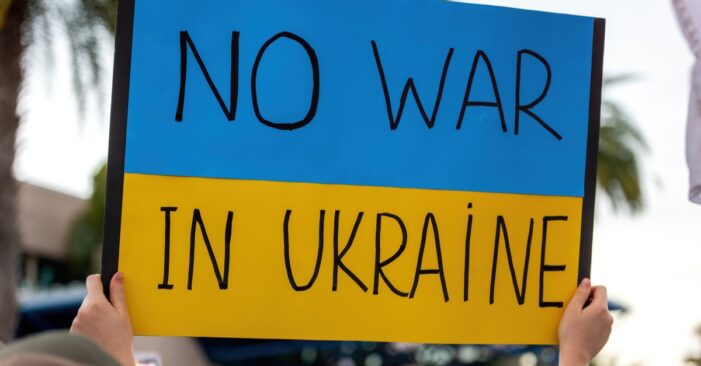Hallandale, Florida, USA. February 24th 2022. Miami: Ukraine War Protest. Protest against Russian invasion of Ukraine. Some Ukraine Anti War signs and banners. (Shutterstock)
By David Lyons, Sun Sentinel
Just hours after Russian military forces invaded their homeland, members of the Ukrainian community in South Florida protested the incursion with a rally in Hallandale Beach and voiced hopes for the safety of friends and relatives who have taken shelter or fled the country.
The United Nations refugee agency, UNHCR, estimates that more than 100,000 people were believed to have left their homes in Ukraine and that up to 4 million may flee to other countries, the Associated Press reported.
But whether any of them can take refuge in the United States in the near future remained an open question on Friday.
The Biden Administration has yet to decide on whether to add to protections available to Ukrainians who seek to come here.
Just hours after Russian military forces invaded their homeland, members of the Ukrainian community in South Florida protested the incursion with a rally in Hallandale Beach and voiced hopes for the safety of friends and relatives who have taken shelter or fled the country.
The United Nations refugee agency, UNHCR, estimates that more than 100,000 people were believed to have left their homes in Ukraine and that up to 4 million may flee to other countries, the Associated Press reported.
But whether any of them can take refuge in the United States in the near future remained an open question on Friday.
The Biden Administration has yet to decide on whether to add to protections available to Ukrainians who seek to come here.
William Gerstein, a Fort Lauderdale immigration lawyer with Gerstein & Gerstein P.A., said Ukrainians currently visiting the U.S. could be granted temporary protected status. The U.S. has granted the status to Venezuelans living in the country after they fled the authoritarian regime of strongman and disputed President Nicolás Maduro.
CBS News, citing unidentified sources, reported Friday that the Biden Administration is considering protecting some Ukrainians now in the U.S. from deportation. The protection would come either through TPS or so-called Deferred Enforced Departure orders.
“U.S. citizens with Ukrainian family have always had the ability to sponsor their family but may not have thought to act on it in the past,” Gerstein said. “For an individual to be brought to the U.S. that does not have a tourist visa or cannot get one, there is humanitarian parole available for situations such as these.”
Under humanitarian parole, refugees with “a compelling emergency” and an “urgent humanitarian reason” may be allowed to temporarily enter the United States, according to a U.S. Citizenship and Immigration Services website.
Refugee status is granted indefinitely and has no expiration date. But refugees are required to apply for permanent residency or green card status a year after living in the U.S., according to the agency.
Gerstein said he has one client who lives close to the hotly contested Donbas region in the southeast of Ukraine.
“They are trying to hunker down and not be on the move,” he said.
Refugees seeking to stay in the U.S. “are a more complex lot” than those living here under temporary status, lawyers say.
Both take considerable time, said David Abraham, professor emeritus of law at the University of Miami School of Law who specializes in immigration and refugee law and the political economy of Europe.
“The normal route would require one or two things: an asylum application which would require getting to the U.S. and asking at the airport for asylum on the grounds of persecution back home,” Abraham said. “That process is one at a time and you have to get here to do it.”
The other route takes refugees through camps managed by the United Nations “and that process can take two years,” Abraham said.
Eligibility for refugee status is determined on a case-by-case basis through interviews with officers with the U.S. Citizenship and Immigration Service, according to the agency’s website.
During the interview, an officer examines “all relevant evidence, including testimony.” The agency considers “the conditions in the country of origin” and evaluates the person’s credibility.
“We also confirm that security checks have been completed and the results of the checks are reviewed and analyzed before approval,” the agency says.
But as the invasion and subsequent geo-political picture unfolds, it is unclear about where Ukrainians will want to end up if their country is overtaken.
Open arms from European Union
According to the Associated Press, Poland, Germany, Hungary and Italy are taking in people fleeing the conflict.
Exacerbating the pain is the division of family members and a fierce loyalty to their country. Most refugees arriving in neighboring countries are women, children and the elderly, according to reports. That’s because men of military age are required to stay and help defend the country.
“If there is any chance to return, a lot of people will want to return to it,” Abraham said.
For now, Poland, which borders Ukraine on the west, is a prime destination for those seeking immediate refuge. But Abraham, citing uneasy historical relations between the two countries, suggested Poland may be more of transition point for Ukrainians than a long-term landing spot.
“Depending on the reception of places like Poland, which may be initially warm out of anti-Russian feeling, there is still a lot of xenophobic sentiment in Poland,” he said. “The history of Polish-Ukrainian relations is not a happy one.”
He suggested Poland’s “primary value is its membership in the European Union which enables you to get to Berlin or Paris or a lot of more desirable places. I think the overwhelming majority will want to go home.”

